Comprehensive Report on Lesson Planning for Effective Education
VerifiedAdded on 2023/06/14
|18
|5648
|215
Report
AI Summary
This report comprehensively explores lesson planning within the education sector, emphasizing its role as a roadmap for effective instruction. Task 1 details the purpose of lesson planning, features of operative plans, attainment of goals and objectives, learning styles and taxonomies, and the importance of flexibility and adaptability. It also examines the influence of lesson plan design on inclusive learning and teaching methods. Task 2 provides an exemplar lesson plan designed to meet diverse learner needs, along with methods for evaluating learner achievements and incorporating feedback. Task 3 defines assessment and evaluation, evaluates different methods for ascertainment and analysis, uses differential assessments for incorporating learner needs, and analyzes how results can inform lesson planning. The report highlights the significance of well-structured and inclusive lesson plans in enhancing the learning experience for all students.
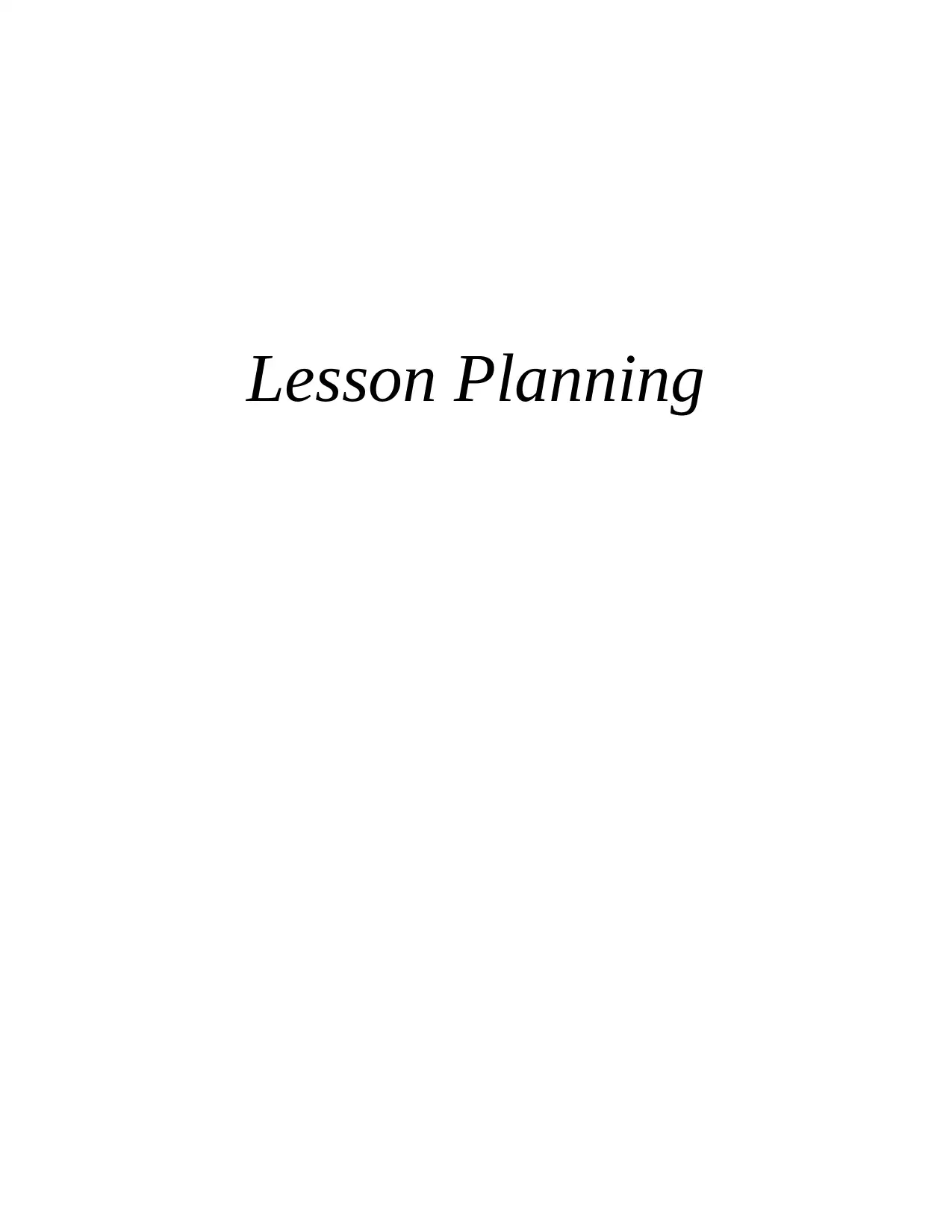
Lesson Planning
Paraphrase This Document
Need a fresh take? Get an instant paraphrase of this document with our AI Paraphraser
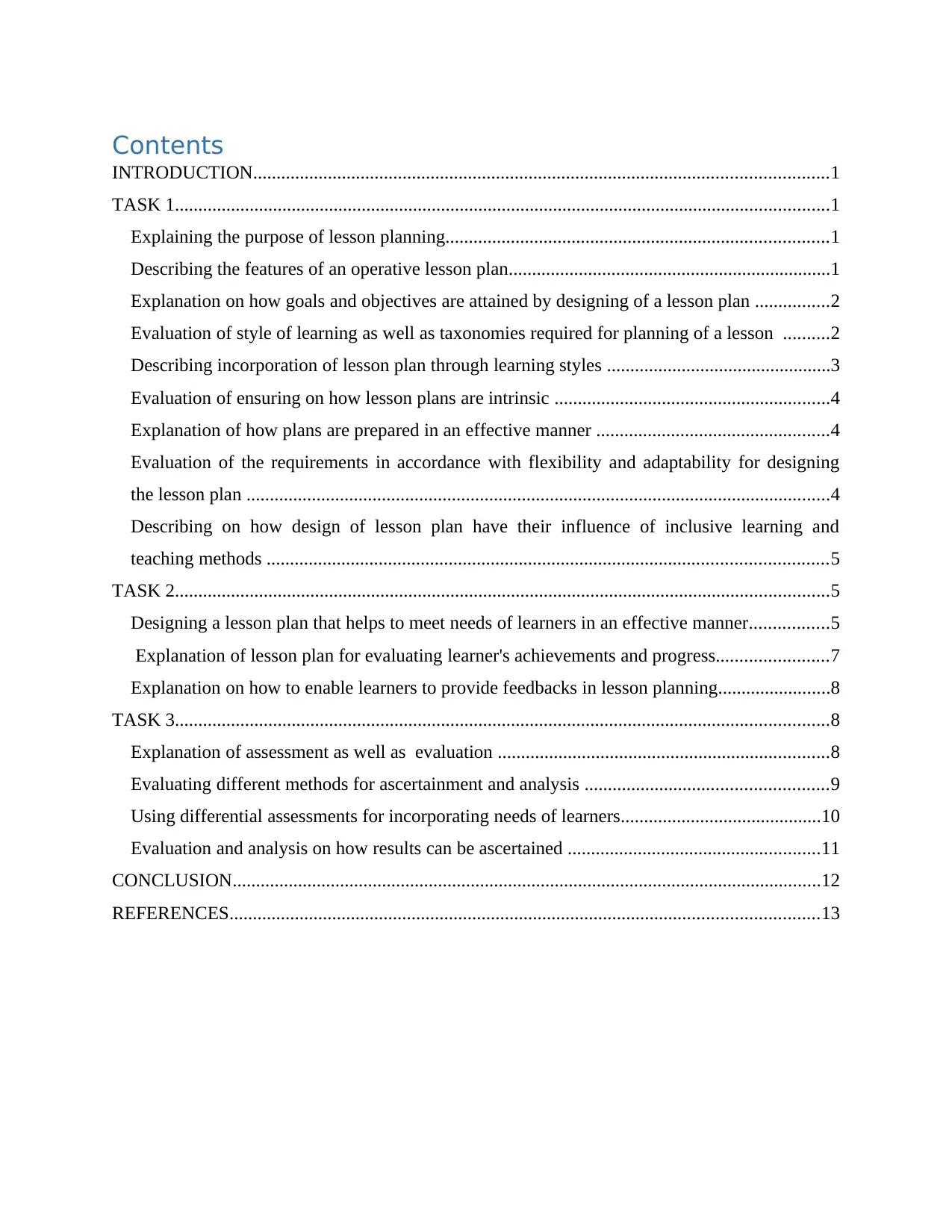
Contents
INTRODUCTION...........................................................................................................................1
TASK 1............................................................................................................................................1
Explaining the purpose of lesson planning..................................................................................1
Describing the features of an operative lesson plan.....................................................................1
Explanation on how goals and objectives are attained by designing of a lesson plan ................2
Evaluation of style of learning as well as taxonomies required for planning of a lesson ..........2
Describing incorporation of lesson plan through learning styles ................................................3
Evaluation of ensuring on how lesson plans are intrinsic ...........................................................4
Explanation of how plans are prepared in an effective manner ..................................................4
Evaluation of the requirements in accordance with flexibility and adaptability for designing
the lesson plan .............................................................................................................................4
Describing on how design of lesson plan have their influence of inclusive learning and
teaching methods ........................................................................................................................5
TASK 2............................................................................................................................................5
Designing a lesson plan that helps to meet needs of learners in an effective manner.................5
Explanation of lesson plan for evaluating learner's achievements and progress........................7
Explanation on how to enable learners to provide feedbacks in lesson planning........................8
TASK 3............................................................................................................................................8
Explanation of assessment as well as evaluation .......................................................................8
Evaluating different methods for ascertainment and analysis ....................................................9
Using differential assessments for incorporating needs of learners...........................................10
Evaluation and analysis on how results can be ascertained ......................................................11
CONCLUSION..............................................................................................................................12
REFERENCES..............................................................................................................................13
INTRODUCTION...........................................................................................................................1
TASK 1............................................................................................................................................1
Explaining the purpose of lesson planning..................................................................................1
Describing the features of an operative lesson plan.....................................................................1
Explanation on how goals and objectives are attained by designing of a lesson plan ................2
Evaluation of style of learning as well as taxonomies required for planning of a lesson ..........2
Describing incorporation of lesson plan through learning styles ................................................3
Evaluation of ensuring on how lesson plans are intrinsic ...........................................................4
Explanation of how plans are prepared in an effective manner ..................................................4
Evaluation of the requirements in accordance with flexibility and adaptability for designing
the lesson plan .............................................................................................................................4
Describing on how design of lesson plan have their influence of inclusive learning and
teaching methods ........................................................................................................................5
TASK 2............................................................................................................................................5
Designing a lesson plan that helps to meet needs of learners in an effective manner.................5
Explanation of lesson plan for evaluating learner's achievements and progress........................7
Explanation on how to enable learners to provide feedbacks in lesson planning........................8
TASK 3............................................................................................................................................8
Explanation of assessment as well as evaluation .......................................................................8
Evaluating different methods for ascertainment and analysis ....................................................9
Using differential assessments for incorporating needs of learners...........................................10
Evaluation and analysis on how results can be ascertained ......................................................11
CONCLUSION..............................................................................................................................12
REFERENCES..............................................................................................................................13

⊘ This is a preview!⊘
Do you want full access?
Subscribe today to unlock all pages.

Trusted by 1+ million students worldwide

INTRODUCTION
The term lesson planning is said to a road map of instructions of what a student is required
to learn as well as the ways it will be done in class time effectively (Anderson, 2021). In
education sector, a lesson plan is consider as a direction which is used by teacher or professor for
deciding how the student learns in an effective manner.
The assignment is prepared in three tasks, wherein Task 1 is guidance document that covers
purpose of designing the lesson plan and features that helps in framing productive plans, ways
for designing lesson plan, learning styles and taxonomies, requirement for flexibility along with
adaptability in designing lesson plans. On other hand, Task 2 is exemplar lesson plans that
covers preparing lesson plans on a topic that is language that demonstrate ways for preparing for
delivery of education and training. Likewise, Task 3 covers definition and methods of
assessment and evaluation along with the ways in which analysis of results of assessments and
evaluation results used for inform lesson planning.
TASK 1
Explaining the purpose of a lesson planning
In teaching world, purpose of lesson planning is to determine objective of lessons,
emphasis on parts of curriculum and ways to attain goals for students (Baker and Bordeaux,
2019). when an infividual set its aim for planning a lesson it becomes easier for teachers and
students to devise decisions for procedures, materials, etc which are required to be presented in a
lesson.
Describing the features of an operative lesson plan
Effective lesson plan addresses together which integrates objectives for learning of student.
This also delves the understanding of lesson plan for teaching or learning practices and strategies
that fulfils the need of individuals. (Eckhoff, 2017) . Key characteristics of effective lesson plan
are as described:
Proper provision for recapitulation: Within effective lesson plan, there must be proper
provision about recapitulation for viewing evaluation of subject matter that are taught to
students.
1
The term lesson planning is said to a road map of instructions of what a student is required
to learn as well as the ways it will be done in class time effectively (Anderson, 2021). In
education sector, a lesson plan is consider as a direction which is used by teacher or professor for
deciding how the student learns in an effective manner.
The assignment is prepared in three tasks, wherein Task 1 is guidance document that covers
purpose of designing the lesson plan and features that helps in framing productive plans, ways
for designing lesson plan, learning styles and taxonomies, requirement for flexibility along with
adaptability in designing lesson plans. On other hand, Task 2 is exemplar lesson plans that
covers preparing lesson plans on a topic that is language that demonstrate ways for preparing for
delivery of education and training. Likewise, Task 3 covers definition and methods of
assessment and evaluation along with the ways in which analysis of results of assessments and
evaluation results used for inform lesson planning.
TASK 1
Explaining the purpose of a lesson planning
In teaching world, purpose of lesson planning is to determine objective of lessons,
emphasis on parts of curriculum and ways to attain goals for students (Baker and Bordeaux,
2019). when an infividual set its aim for planning a lesson it becomes easier for teachers and
students to devise decisions for procedures, materials, etc which are required to be presented in a
lesson.
Describing the features of an operative lesson plan
Effective lesson plan addresses together which integrates objectives for learning of student.
This also delves the understanding of lesson plan for teaching or learning practices and strategies
that fulfils the need of individuals. (Eckhoff, 2017) . Key characteristics of effective lesson plan
are as described:
Proper provision for recapitulation: Within effective lesson plan, there must be proper
provision about recapitulation for viewing evaluation of subject matter that are taught to
students.
1
Paraphrase This Document
Need a fresh take? Get an instant paraphrase of this document with our AI Paraphraser
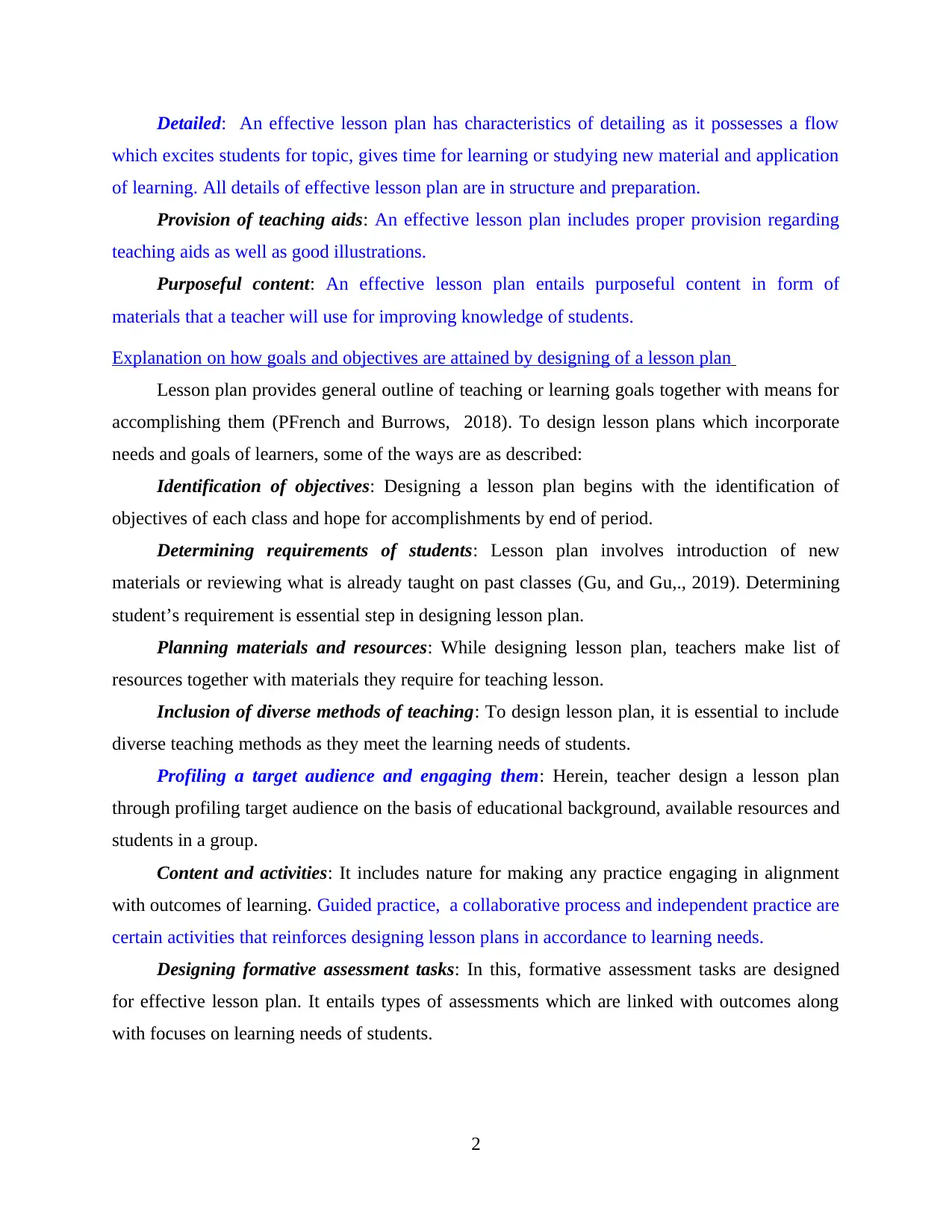
Detailed: An effective lesson plan has characteristics of detailing as it possesses a flow
which excites students for topic, gives time for learning or studying new material and application
of learning. All details of effective lesson plan are in structure and preparation.
Provision of teaching aids: An effective lesson plan includes proper provision regarding
teaching aids as well as good illustrations.
Purposeful content: An effective lesson plan entails purposeful content in form of
materials that a teacher will use for improving knowledge of students.
Explanation on how goals and objectives are attained by designing of a lesson plan
Lesson plan provides general outline of teaching or learning goals together with means for
accomplishing them (PFrench and Burrows, 2018). To design lesson plans which incorporate
needs and goals of learners, some of the ways are as described:
Identification of objectives: Designing a lesson plan begins with the identification of
objectives of each class and hope for accomplishments by end of period.
Determining requirements of students: Lesson plan involves introduction of new
materials or reviewing what is already taught on past classes (Gu, and Gu,., 2019). Determining
student’s requirement is essential step in designing lesson plan.
Planning materials and resources: While designing lesson plan, teachers make list of
resources together with materials they require for teaching lesson.
Inclusion of diverse methods of teaching: To design lesson plan, it is essential to include
diverse teaching methods as they meet the learning needs of students.
Profiling a target audience and engaging them: Herein, teacher design a lesson plan
through profiling target audience on the basis of educational background, available resources and
students in a group.
Content and activities: It includes nature for making any practice engaging in alignment
with outcomes of learning. Guided practice, a collaborative process and independent practice are
certain activities that reinforces designing lesson plans in accordance to learning needs.
Designing formative assessment tasks: In this, formative assessment tasks are designed
for effective lesson plan. It entails types of assessments which are linked with outcomes along
with focuses on learning needs of students.
2
which excites students for topic, gives time for learning or studying new material and application
of learning. All details of effective lesson plan are in structure and preparation.
Provision of teaching aids: An effective lesson plan includes proper provision regarding
teaching aids as well as good illustrations.
Purposeful content: An effective lesson plan entails purposeful content in form of
materials that a teacher will use for improving knowledge of students.
Explanation on how goals and objectives are attained by designing of a lesson plan
Lesson plan provides general outline of teaching or learning goals together with means for
accomplishing them (PFrench and Burrows, 2018). To design lesson plans which incorporate
needs and goals of learners, some of the ways are as described:
Identification of objectives: Designing a lesson plan begins with the identification of
objectives of each class and hope for accomplishments by end of period.
Determining requirements of students: Lesson plan involves introduction of new
materials or reviewing what is already taught on past classes (Gu, and Gu,., 2019). Determining
student’s requirement is essential step in designing lesson plan.
Planning materials and resources: While designing lesson plan, teachers make list of
resources together with materials they require for teaching lesson.
Inclusion of diverse methods of teaching: To design lesson plan, it is essential to include
diverse teaching methods as they meet the learning needs of students.
Profiling a target audience and engaging them: Herein, teacher design a lesson plan
through profiling target audience on the basis of educational background, available resources and
students in a group.
Content and activities: It includes nature for making any practice engaging in alignment
with outcomes of learning. Guided practice, a collaborative process and independent practice are
certain activities that reinforces designing lesson plans in accordance to learning needs.
Designing formative assessment tasks: In this, formative assessment tasks are designed
for effective lesson plan. It entails types of assessments which are linked with outcomes along
with focuses on learning needs of students.
2
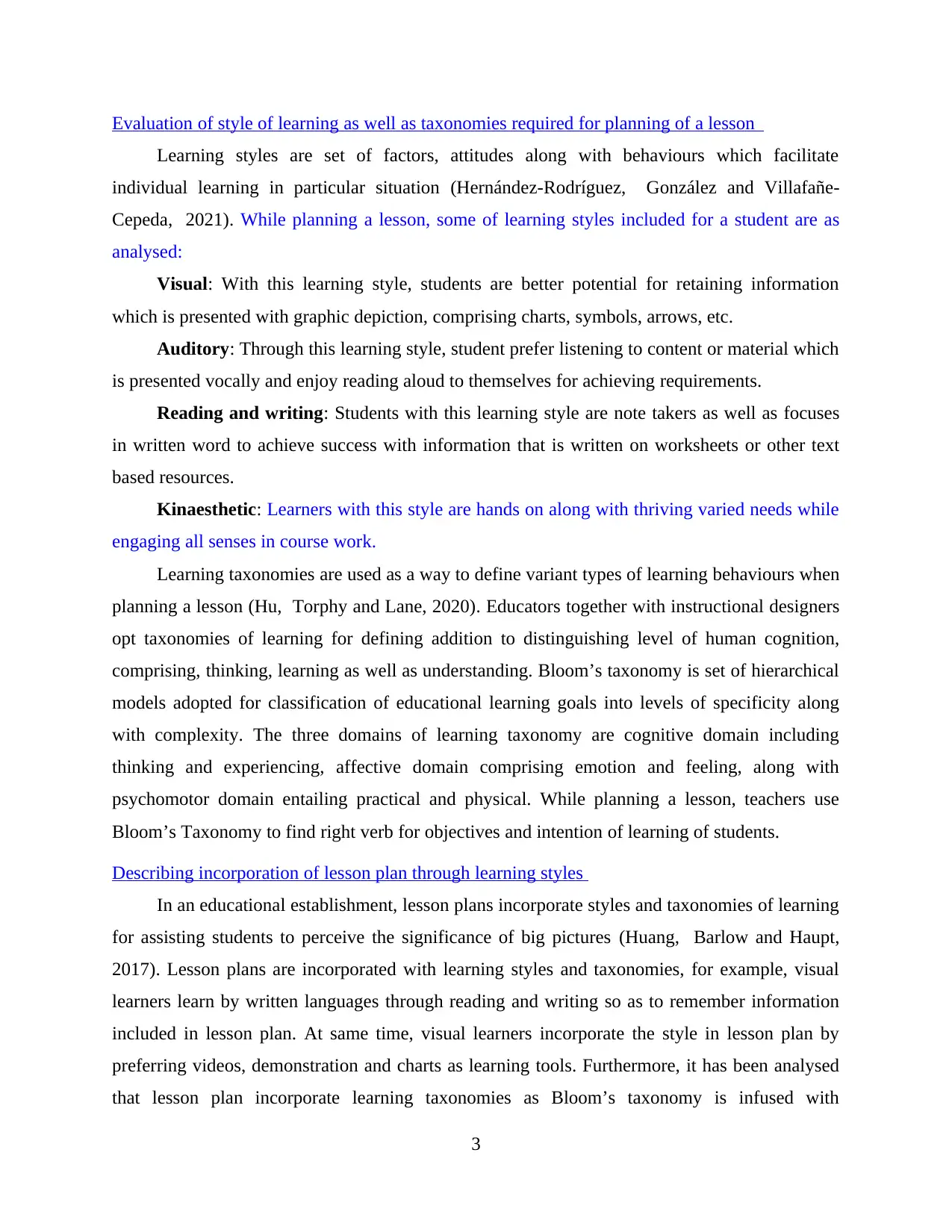
Evaluation of style of learning as well as taxonomies required for planning of a lesson
Learning styles are set of factors, attitudes along with behaviours which facilitate
individual learning in particular situation (Hernández-Rodríguez, González and Villafañe-
Cepeda, 2021). While planning a lesson, some of learning styles included for a student are as
analysed:
Visual: With this learning style, students are better potential for retaining information
which is presented with graphic depiction, comprising charts, symbols, arrows, etc.
Auditory: Through this learning style, student prefer listening to content or material which
is presented vocally and enjoy reading aloud to themselves for achieving requirements.
Reading and writing: Students with this learning style are note takers as well as focuses
in written word to achieve success with information that is written on worksheets or other text
based resources.
Kinaesthetic: Learners with this style are hands on along with thriving varied needs while
engaging all senses in course work.
Learning taxonomies are used as a way to define variant types of learning behaviours when
planning a lesson (Hu, Torphy and Lane, 2020). Educators together with instructional designers
opt taxonomies of learning for defining addition to distinguishing level of human cognition,
comprising, thinking, learning as well as understanding. Bloom’s taxonomy is set of hierarchical
models adopted for classification of educational learning goals into levels of specificity along
with complexity. The three domains of learning taxonomy are cognitive domain including
thinking and experiencing, affective domain comprising emotion and feeling, along with
psychomotor domain entailing practical and physical. While planning a lesson, teachers use
Bloom’s Taxonomy to find right verb for objectives and intention of learning of students.
Describing incorporation of lesson plan through learning styles
In an educational establishment, lesson plans incorporate styles and taxonomies of learning
for assisting students to perceive the significance of big pictures (Huang, Barlow and Haupt,
2017). Lesson plans are incorporated with learning styles and taxonomies, for example, visual
learners learn by written languages through reading and writing so as to remember information
included in lesson plan. At same time, visual learners incorporate the style in lesson plan by
preferring videos, demonstration and charts as learning tools. Furthermore, it has been analysed
that lesson plan incorporate learning taxonomies as Bloom’s taxonomy is infused with
3
Learning styles are set of factors, attitudes along with behaviours which facilitate
individual learning in particular situation (Hernández-Rodríguez, González and Villafañe-
Cepeda, 2021). While planning a lesson, some of learning styles included for a student are as
analysed:
Visual: With this learning style, students are better potential for retaining information
which is presented with graphic depiction, comprising charts, symbols, arrows, etc.
Auditory: Through this learning style, student prefer listening to content or material which
is presented vocally and enjoy reading aloud to themselves for achieving requirements.
Reading and writing: Students with this learning style are note takers as well as focuses
in written word to achieve success with information that is written on worksheets or other text
based resources.
Kinaesthetic: Learners with this style are hands on along with thriving varied needs while
engaging all senses in course work.
Learning taxonomies are used as a way to define variant types of learning behaviours when
planning a lesson (Hu, Torphy and Lane, 2020). Educators together with instructional designers
opt taxonomies of learning for defining addition to distinguishing level of human cognition,
comprising, thinking, learning as well as understanding. Bloom’s taxonomy is set of hierarchical
models adopted for classification of educational learning goals into levels of specificity along
with complexity. The three domains of learning taxonomy are cognitive domain including
thinking and experiencing, affective domain comprising emotion and feeling, along with
psychomotor domain entailing practical and physical. While planning a lesson, teachers use
Bloom’s Taxonomy to find right verb for objectives and intention of learning of students.
Describing incorporation of lesson plan through learning styles
In an educational establishment, lesson plans incorporate styles and taxonomies of learning
for assisting students to perceive the significance of big pictures (Huang, Barlow and Haupt,
2017). Lesson plans are incorporated with learning styles and taxonomies, for example, visual
learners learn by written languages through reading and writing so as to remember information
included in lesson plan. At same time, visual learners incorporate the style in lesson plan by
preferring videos, demonstration and charts as learning tools. Furthermore, it has been analysed
that lesson plan incorporate learning taxonomies as Bloom’s taxonomy is infused with
3
⊘ This is a preview!⊘
Do you want full access?
Subscribe today to unlock all pages.

Trusted by 1+ million students worldwide
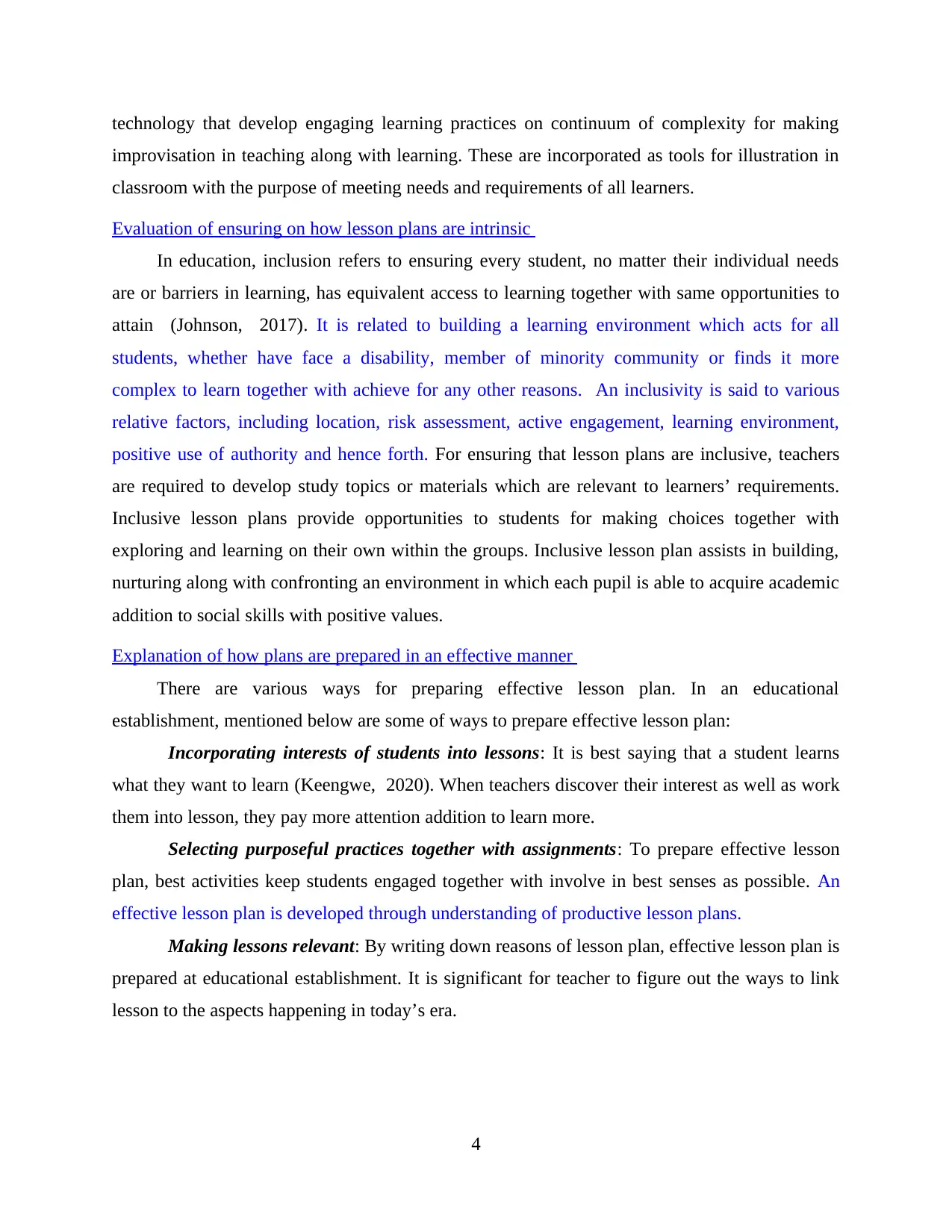
technology that develop engaging learning practices on continuum of complexity for making
improvisation in teaching along with learning. These are incorporated as tools for illustration in
classroom with the purpose of meeting needs and requirements of all learners.
Evaluation of ensuring on how lesson plans are intrinsic
In education, inclusion refers to ensuring every student, no matter their individual needs
are or barriers in learning, has equivalent access to learning together with same opportunities to
attain (Johnson, 2017). It is related to building a learning environment which acts for all
students, whether have face a disability, member of minority community or finds it more
complex to learn together with achieve for any other reasons. An inclusivity is said to various
relative factors, including location, risk assessment, active engagement, learning environment,
positive use of authority and hence forth. For ensuring that lesson plans are inclusive, teachers
are required to develop study topics or materials which are relevant to learners’ requirements.
Inclusive lesson plans provide opportunities to students for making choices together with
exploring and learning on their own within the groups. Inclusive lesson plan assists in building,
nurturing along with confronting an environment in which each pupil is able to acquire academic
addition to social skills with positive values.
Explanation of how plans are prepared in an effective manner
There are various ways for preparing effective lesson plan. In an educational
establishment, mentioned below are some of ways to prepare effective lesson plan:
Incorporating interests of students into lessons: It is best saying that a student learns
what they want to learn (Keengwe, 2020). When teachers discover their interest as well as work
them into lesson, they pay more attention addition to learn more.
Selecting purposeful practices together with assignments: To prepare effective lesson
plan, best activities keep students engaged together with involve in best senses as possible. An
effective lesson plan is developed through understanding of productive lesson plans.
Making lessons relevant: By writing down reasons of lesson plan, effective lesson plan is
prepared at educational establishment. It is significant for teacher to figure out the ways to link
lesson to the aspects happening in today’s era.
4
improvisation in teaching along with learning. These are incorporated as tools for illustration in
classroom with the purpose of meeting needs and requirements of all learners.
Evaluation of ensuring on how lesson plans are intrinsic
In education, inclusion refers to ensuring every student, no matter their individual needs
are or barriers in learning, has equivalent access to learning together with same opportunities to
attain (Johnson, 2017). It is related to building a learning environment which acts for all
students, whether have face a disability, member of minority community or finds it more
complex to learn together with achieve for any other reasons. An inclusivity is said to various
relative factors, including location, risk assessment, active engagement, learning environment,
positive use of authority and hence forth. For ensuring that lesson plans are inclusive, teachers
are required to develop study topics or materials which are relevant to learners’ requirements.
Inclusive lesson plans provide opportunities to students for making choices together with
exploring and learning on their own within the groups. Inclusive lesson plan assists in building,
nurturing along with confronting an environment in which each pupil is able to acquire academic
addition to social skills with positive values.
Explanation of how plans are prepared in an effective manner
There are various ways for preparing effective lesson plan. In an educational
establishment, mentioned below are some of ways to prepare effective lesson plan:
Incorporating interests of students into lessons: It is best saying that a student learns
what they want to learn (Keengwe, 2020). When teachers discover their interest as well as work
them into lesson, they pay more attention addition to learn more.
Selecting purposeful practices together with assignments: To prepare effective lesson
plan, best activities keep students engaged together with involve in best senses as possible. An
effective lesson plan is developed through understanding of productive lesson plans.
Making lessons relevant: By writing down reasons of lesson plan, effective lesson plan is
prepared at educational establishment. It is significant for teacher to figure out the ways to link
lesson to the aspects happening in today’s era.
4
Paraphrase This Document
Need a fresh take? Get an instant paraphrase of this document with our AI Paraphraser
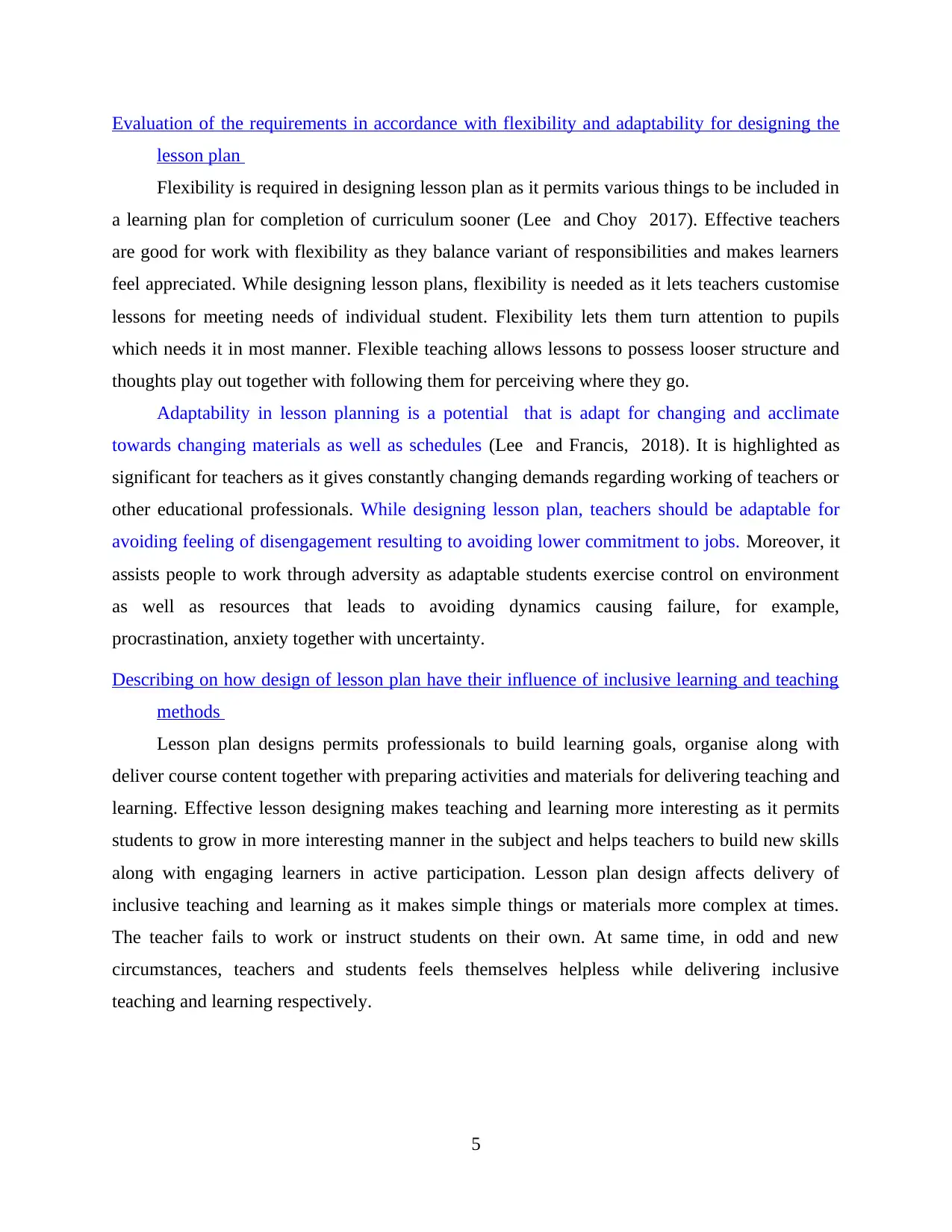
Evaluation of the requirements in accordance with flexibility and adaptability for designing the
lesson plan
Flexibility is required in designing lesson plan as it permits various things to be included in
a learning plan for completion of curriculum sooner (Lee and Choy 2017). Effective teachers
are good for work with flexibility as they balance variant of responsibilities and makes learners
feel appreciated. While designing lesson plans, flexibility is needed as it lets teachers customise
lessons for meeting needs of individual student. Flexibility lets them turn attention to pupils
which needs it in most manner. Flexible teaching allows lessons to possess looser structure and
thoughts play out together with following them for perceiving where they go.
Adaptability in lesson planning is a potential that is adapt for changing and acclimate
towards changing materials as well as schedules (Lee and Francis, 2018). It is highlighted as
significant for teachers as it gives constantly changing demands regarding working of teachers or
other educational professionals. While designing lesson plan, teachers should be adaptable for
avoiding feeling of disengagement resulting to avoiding lower commitment to jobs. Moreover, it
assists people to work through adversity as adaptable students exercise control on environment
as well as resources that leads to avoiding dynamics causing failure, for example,
procrastination, anxiety together with uncertainty.
Describing on how design of lesson plan have their influence of inclusive learning and teaching
methods
Lesson plan designs permits professionals to build learning goals, organise along with
deliver course content together with preparing activities and materials for delivering teaching and
learning. Effective lesson designing makes teaching and learning more interesting as it permits
students to grow in more interesting manner in the subject and helps teachers to build new skills
along with engaging learners in active participation. Lesson plan design affects delivery of
inclusive teaching and learning as it makes simple things or materials more complex at times.
The teacher fails to work or instruct students on their own. At same time, in odd and new
circumstances, teachers and students feels themselves helpless while delivering inclusive
teaching and learning respectively.
5
lesson plan
Flexibility is required in designing lesson plan as it permits various things to be included in
a learning plan for completion of curriculum sooner (Lee and Choy 2017). Effective teachers
are good for work with flexibility as they balance variant of responsibilities and makes learners
feel appreciated. While designing lesson plans, flexibility is needed as it lets teachers customise
lessons for meeting needs of individual student. Flexibility lets them turn attention to pupils
which needs it in most manner. Flexible teaching allows lessons to possess looser structure and
thoughts play out together with following them for perceiving where they go.
Adaptability in lesson planning is a potential that is adapt for changing and acclimate
towards changing materials as well as schedules (Lee and Francis, 2018). It is highlighted as
significant for teachers as it gives constantly changing demands regarding working of teachers or
other educational professionals. While designing lesson plan, teachers should be adaptable for
avoiding feeling of disengagement resulting to avoiding lower commitment to jobs. Moreover, it
assists people to work through adversity as adaptable students exercise control on environment
as well as resources that leads to avoiding dynamics causing failure, for example,
procrastination, anxiety together with uncertainty.
Describing on how design of lesson plan have their influence of inclusive learning and teaching
methods
Lesson plan designs permits professionals to build learning goals, organise along with
deliver course content together with preparing activities and materials for delivering teaching and
learning. Effective lesson designing makes teaching and learning more interesting as it permits
students to grow in more interesting manner in the subject and helps teachers to build new skills
along with engaging learners in active participation. Lesson plan design affects delivery of
inclusive teaching and learning as it makes simple things or materials more complex at times.
The teacher fails to work or instruct students on their own. At same time, in odd and new
circumstances, teachers and students feels themselves helpless while delivering inclusive
teaching and learning respectively.
5
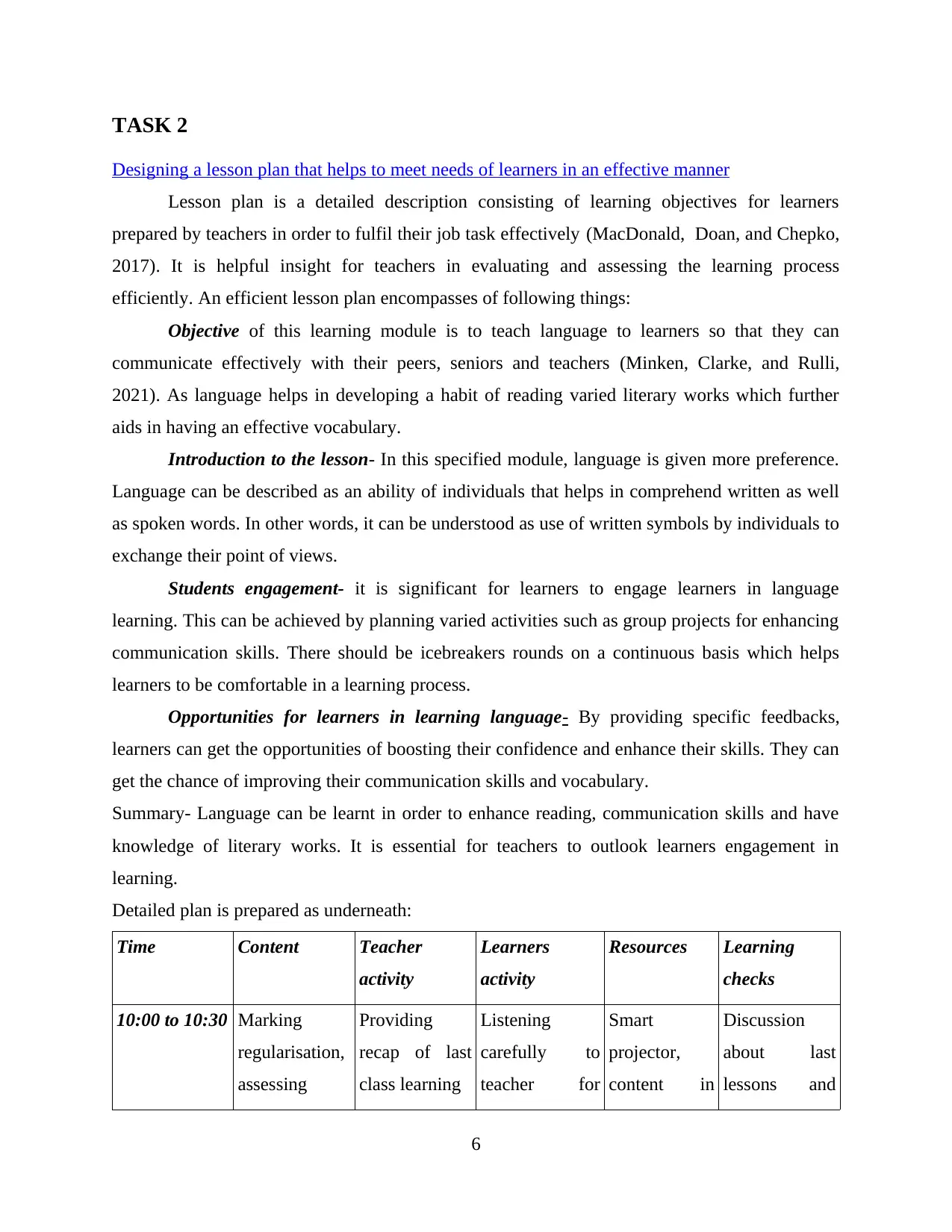
TASK 2
Designing a lesson plan that helps to meet needs of learners in an effective manner
Lesson plan is a detailed description consisting of learning objectives for learners
prepared by teachers in order to fulfil their job task effectively (MacDonald, Doan, and Chepko,
2017). It is helpful insight for teachers in evaluating and assessing the learning process
efficiently. An efficient lesson plan encompasses of following things:
Objective of this learning module is to teach language to learners so that they can
communicate effectively with their peers, seniors and teachers (Minken, Clarke, and Rulli,
2021). As language helps in developing a habit of reading varied literary works which further
aids in having an effective vocabulary.
Introduction to the lesson- In this specified module, language is given more preference.
Language can be described as an ability of individuals that helps in comprehend written as well
as spoken words. In other words, it can be understood as use of written symbols by individuals to
exchange their point of views.
Students engagement- it is significant for learners to engage learners in language
learning. This can be achieved by planning varied activities such as group projects for enhancing
communication skills. There should be icebreakers rounds on a continuous basis which helps
learners to be comfortable in a learning process.
Opportunities for learners in learning language- By providing specific feedbacks,
learners can get the opportunities of boosting their confidence and enhance their skills. They can
get the chance of improving their communication skills and vocabulary.
Summary- Language can be learnt in order to enhance reading, communication skills and have
knowledge of literary works. It is essential for teachers to outlook learners engagement in
learning.
Detailed plan is prepared as underneath:
Time Content Teacher
activity
Learners
activity
Resources Learning
checks
10:00 to 10:30 Marking
regularisation,
assessing
Providing
recap of last
class learning
Listening
carefully to
teacher for
Smart
projector,
content in
Discussion
about last
lessons and
6
Designing a lesson plan that helps to meet needs of learners in an effective manner
Lesson plan is a detailed description consisting of learning objectives for learners
prepared by teachers in order to fulfil their job task effectively (MacDonald, Doan, and Chepko,
2017). It is helpful insight for teachers in evaluating and assessing the learning process
efficiently. An efficient lesson plan encompasses of following things:
Objective of this learning module is to teach language to learners so that they can
communicate effectively with their peers, seniors and teachers (Minken, Clarke, and Rulli,
2021). As language helps in developing a habit of reading varied literary works which further
aids in having an effective vocabulary.
Introduction to the lesson- In this specified module, language is given more preference.
Language can be described as an ability of individuals that helps in comprehend written as well
as spoken words. In other words, it can be understood as use of written symbols by individuals to
exchange their point of views.
Students engagement- it is significant for learners to engage learners in language
learning. This can be achieved by planning varied activities such as group projects for enhancing
communication skills. There should be icebreakers rounds on a continuous basis which helps
learners to be comfortable in a learning process.
Opportunities for learners in learning language- By providing specific feedbacks,
learners can get the opportunities of boosting their confidence and enhance their skills. They can
get the chance of improving their communication skills and vocabulary.
Summary- Language can be learnt in order to enhance reading, communication skills and have
knowledge of literary works. It is essential for teachers to outlook learners engagement in
learning.
Detailed plan is prepared as underneath:
Time Content Teacher
activity
Learners
activity
Resources Learning
checks
10:00 to 10:30 Marking
regularisation,
assessing
Providing
recap of last
class learning
Listening
carefully to
teacher for
Smart
projector,
content in
Discussion
about last
lessons and
6
⊘ This is a preview!⊘
Do you want full access?
Subscribe today to unlock all pages.

Trusted by 1+ million students worldwide

students
practice
having
remembrance
about last
lessons.
laptop. assessing
learner
memory.
10:30- 12:00 Practising
open
discussions
about
language topic
Telling
objectives and
outcomes of
language
learning,
giving
assignment for
practising at
home
Keenly
participate in
learning,
effective
listening and
completion of
given tasks
Virtual
classroom, all
learners
having
laptops and
access to
internet
connectivity.
Assignment
practice, peer-
to-peer
discussion and
presentation
on given topic
12:00-1:00 Identifying
learning
outcomes
based on
previous
presentation
and learnings
Telling
benefits and
drawbacks of
learning
language
Listening to
teachers and
attending
seminars to
enhance
communication
skills.
Projectors,
power point
slides and
access to
internet.
Presentations,
group tasks,
Questions
round.
Explanation of lesson plan for evaluating learner achievements and progress
It is a crucial job for teachers to assess their learner achievements and progress during
learning of language module effectively. As through efficient monitoring and continuous
feedbacks, learners felt that their work is being checked and will try to improvise them. Varied
techniques used by teachers in order to evaluate learners about their progress and achievements
are discussed below:
Grading is an effective way through which teachers evaluate performance of individual's
learning on a continuous basis (Moore-Cox, 2017). Learners will always try to improve their
7
practice
having
remembrance
about last
lessons.
laptop. assessing
learner
memory.
10:30- 12:00 Practising
open
discussions
about
language topic
Telling
objectives and
outcomes of
language
learning,
giving
assignment for
practising at
home
Keenly
participate in
learning,
effective
listening and
completion of
given tasks
Virtual
classroom, all
learners
having
laptops and
access to
internet
connectivity.
Assignment
practice, peer-
to-peer
discussion and
presentation
on given topic
12:00-1:00 Identifying
learning
outcomes
based on
previous
presentation
and learnings
Telling
benefits and
drawbacks of
learning
language
Listening to
teachers and
attending
seminars to
enhance
communication
skills.
Projectors,
power point
slides and
access to
internet.
Presentations,
group tasks,
Questions
round.
Explanation of lesson plan for evaluating learner achievements and progress
It is a crucial job for teachers to assess their learner achievements and progress during
learning of language module effectively. As through efficient monitoring and continuous
feedbacks, learners felt that their work is being checked and will try to improvise them. Varied
techniques used by teachers in order to evaluate learners about their progress and achievements
are discussed below:
Grading is an effective way through which teachers evaluate performance of individual's
learning on a continuous basis (Moore-Cox, 2017). Learners will always try to improve their
7
Paraphrase This Document
Need a fresh take? Get an instant paraphrase of this document with our AI Paraphraser

grades in order to be more skilful. Teachers provides grades to learners as it helps them to know
their position in learning module.
Questioning- This technique is used by teachers to evaluate learning and grasping skills
of students. It ensures how quickly a learner grasp and understands a lesson. It helps learners to
prepare for their annual test in an effective way.
Homework from previous lessons- It is given by teachers in order to evaluate previous
remembrance of individuals. It is important for learners to have knowledge about their previous
lessons as it helps them to have their enhance their overall skills.
Out loud with the whole class- Under this practice, learners are asked to read a specific
paragraph related to language in order to provide them skill of reading loud (Ramírez, Clemente
and Rodríguez, 2017). This exercise can help other learners in learning by effective listening.
Through this, teachers can evaluate reading skill of learners.
Explanation on how to enable learners to provide feedbacks in lesson planning
It is essential to enable learners in providing feedbacks of lesson planning as it helps to
learn their module in an efficient manner. It can be done through many ways. Such as:
Reporting and recording outcomes- Through this, learners can provide learning outcomes on the
basis of learned skills. These outcomes assists teachers in planning a lesson further for improving
learner's needs. These also help in identifying varied ways in which they can improve their
teaching practices.
Examination results- this can be an effective feedback tool for evaluating learners
experience. As it helps them to assess learned outcomes of individuals. Through this teacher can
learn that its learning process is working or not. It is duty of learners to improve their results and
skills in learning language module.
Assessing individual progress- It is significant for individuals to progress while learning
any module. Assessing individual progress in learning process helps teachers to identify weak
points of every student which helps them to improve their procedure. By evaluating individual's
progress, teachers can plan as per their needs. As every student is not same, it is possible that one
may have excellent learning skills or other has good listening skills. It is responsibility of teacher
to plan accordingly to everyone's specific needs.
Completion of units- In order to assess individual's feedback, teachers can take test after
the completion of units. These provides them an understanding of individual's behaviour in
8
their position in learning module.
Questioning- This technique is used by teachers to evaluate learning and grasping skills
of students. It ensures how quickly a learner grasp and understands a lesson. It helps learners to
prepare for their annual test in an effective way.
Homework from previous lessons- It is given by teachers in order to evaluate previous
remembrance of individuals. It is important for learners to have knowledge about their previous
lessons as it helps them to have their enhance their overall skills.
Out loud with the whole class- Under this practice, learners are asked to read a specific
paragraph related to language in order to provide them skill of reading loud (Ramírez, Clemente
and Rodríguez, 2017). This exercise can help other learners in learning by effective listening.
Through this, teachers can evaluate reading skill of learners.
Explanation on how to enable learners to provide feedbacks in lesson planning
It is essential to enable learners in providing feedbacks of lesson planning as it helps to
learn their module in an efficient manner. It can be done through many ways. Such as:
Reporting and recording outcomes- Through this, learners can provide learning outcomes on the
basis of learned skills. These outcomes assists teachers in planning a lesson further for improving
learner's needs. These also help in identifying varied ways in which they can improve their
teaching practices.
Examination results- this can be an effective feedback tool for evaluating learners
experience. As it helps them to assess learned outcomes of individuals. Through this teacher can
learn that its learning process is working or not. It is duty of learners to improve their results and
skills in learning language module.
Assessing individual progress- It is significant for individuals to progress while learning
any module. Assessing individual progress in learning process helps teachers to identify weak
points of every student which helps them to improve their procedure. By evaluating individual's
progress, teachers can plan as per their needs. As every student is not same, it is possible that one
may have excellent learning skills or other has good listening skills. It is responsibility of teacher
to plan accordingly to everyone's specific needs.
Completion of units- In order to assess individual's feedback, teachers can take test after
the completion of units. These provides them an understanding of individual's behaviour in
8
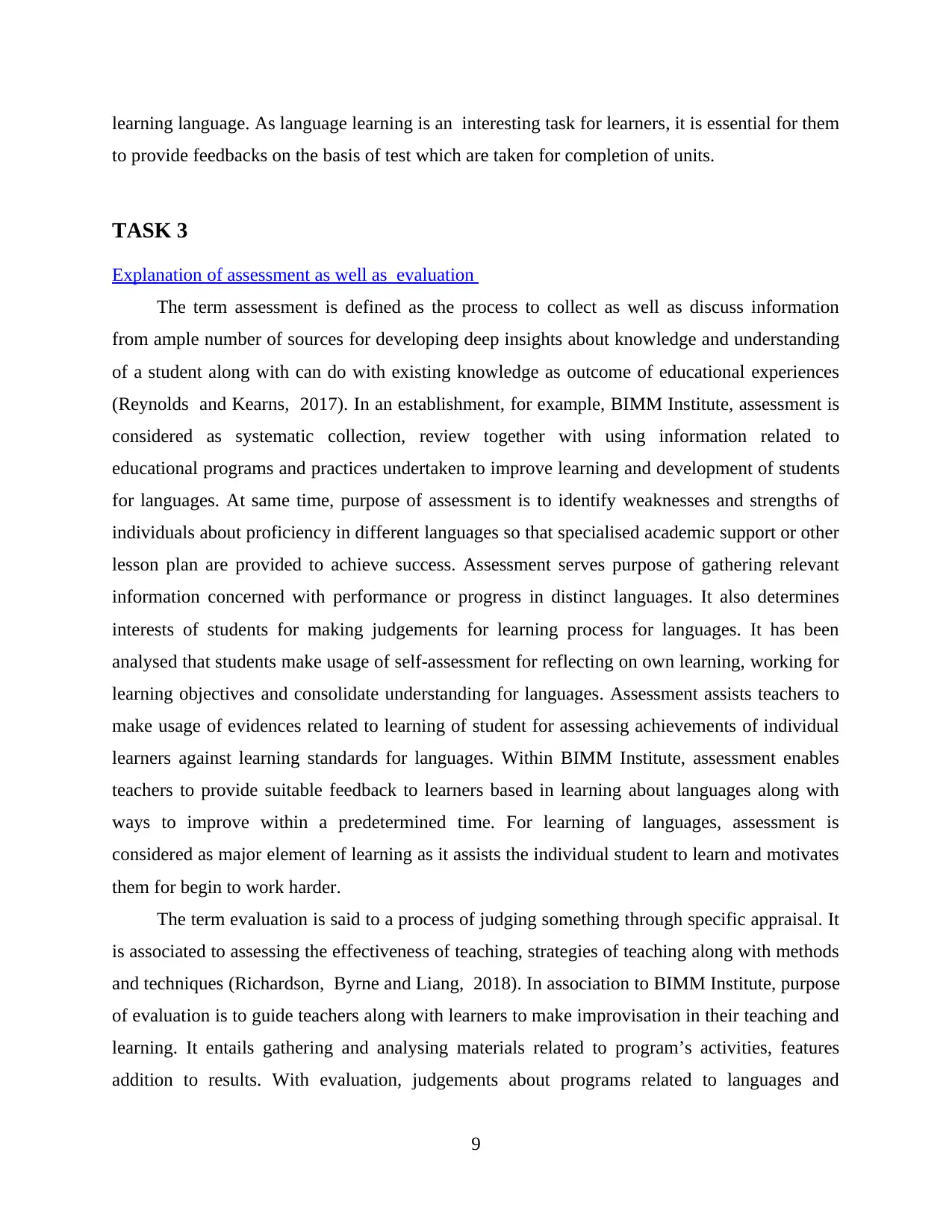
learning language. As language learning is an interesting task for learners, it is essential for them
to provide feedbacks on the basis of test which are taken for completion of units.
TASK 3
Explanation of assessment as well as evaluation
The term assessment is defined as the process to collect as well as discuss information
from ample number of sources for developing deep insights about knowledge and understanding
of a student along with can do with existing knowledge as outcome of educational experiences
(Reynolds and Kearns, 2017). In an establishment, for example, BIMM Institute, assessment is
considered as systematic collection, review together with using information related to
educational programs and practices undertaken to improve learning and development of students
for languages. At same time, purpose of assessment is to identify weaknesses and strengths of
individuals about proficiency in different languages so that specialised academic support or other
lesson plan are provided to achieve success. Assessment serves purpose of gathering relevant
information concerned with performance or progress in distinct languages. It also determines
interests of students for making judgements for learning process for languages. It has been
analysed that students make usage of self-assessment for reflecting on own learning, working for
learning objectives and consolidate understanding for languages. Assessment assists teachers to
make usage of evidences related to learning of student for assessing achievements of individual
learners against learning standards for languages. Within BIMM Institute, assessment enables
teachers to provide suitable feedback to learners based in learning about languages along with
ways to improve within a predetermined time. For learning of languages, assessment is
considered as major element of learning as it assists the individual student to learn and motivates
them for begin to work harder.
The term evaluation is said to a process of judging something through specific appraisal. It
is associated to assessing the effectiveness of teaching, strategies of teaching along with methods
and techniques (Richardson, Byrne and Liang, 2018). In association to BIMM Institute, purpose
of evaluation is to guide teachers along with learners to make improvisation in their teaching and
learning. It entails gathering and analysing materials related to program’s activities, features
addition to results. With evaluation, judgements about programs related to languages and
9
to provide feedbacks on the basis of test which are taken for completion of units.
TASK 3
Explanation of assessment as well as evaluation
The term assessment is defined as the process to collect as well as discuss information
from ample number of sources for developing deep insights about knowledge and understanding
of a student along with can do with existing knowledge as outcome of educational experiences
(Reynolds and Kearns, 2017). In an establishment, for example, BIMM Institute, assessment is
considered as systematic collection, review together with using information related to
educational programs and practices undertaken to improve learning and development of students
for languages. At same time, purpose of assessment is to identify weaknesses and strengths of
individuals about proficiency in different languages so that specialised academic support or other
lesson plan are provided to achieve success. Assessment serves purpose of gathering relevant
information concerned with performance or progress in distinct languages. It also determines
interests of students for making judgements for learning process for languages. It has been
analysed that students make usage of self-assessment for reflecting on own learning, working for
learning objectives and consolidate understanding for languages. Assessment assists teachers to
make usage of evidences related to learning of student for assessing achievements of individual
learners against learning standards for languages. Within BIMM Institute, assessment enables
teachers to provide suitable feedback to learners based in learning about languages along with
ways to improve within a predetermined time. For learning of languages, assessment is
considered as major element of learning as it assists the individual student to learn and motivates
them for begin to work harder.
The term evaluation is said to a process of judging something through specific appraisal. It
is associated to assessing the effectiveness of teaching, strategies of teaching along with methods
and techniques (Richardson, Byrne and Liang, 2018). In association to BIMM Institute, purpose
of evaluation is to guide teachers along with learners to make improvisation in their teaching and
learning. It entails gathering and analysing materials related to program’s activities, features
addition to results. With evaluation, judgements about programs related to languages and
9
⊘ This is a preview!⊘
Do you want full access?
Subscribe today to unlock all pages.

Trusted by 1+ million students worldwide
1 out of 18
Related Documents
Your All-in-One AI-Powered Toolkit for Academic Success.
+13062052269
info@desklib.com
Available 24*7 on WhatsApp / Email
![[object Object]](/_next/static/media/star-bottom.7253800d.svg)
Unlock your academic potential
Copyright © 2020–2025 A2Z Services. All Rights Reserved. Developed and managed by ZUCOL.



